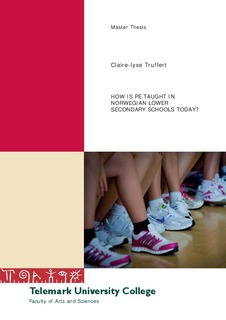How is Physical Education taught in Norwegian lower secondary schools today? A qualitative study among PE teachers.
Master thesis
Published version
Permanent lenke
http://hdl.handle.net/11250/2438807Utgivelsesdato
2016-11-05Metadata
Vis full innførselSamlinger
Originalversjon
Truffert, C. How is Physical Education taught in Norwegian lower secondary schools today? A qualitative study among PE teachers. Master thesis, Telemark University College, 2015Sammendrag
The present study is about motivation in Physical Education (PE). The purpose of this research paper is to gain better knowledge of strategies that teachers of lower secondary schools use to motivate their pupils in PE. The reason for the chosen theme is that motivation is a widely used term that can be difficult to define, even if it seems "easy to understand". Moreover motivation is something that has to be stimulated. My goal was to understand how I as a teacher would affect the motivation of my pupils in the future. I chose therefore to investigate how teachers motivate their pupils in physical education. Methodically I used qualitative interviews of seven teachers in secondary schools in various secondary schools distributed at Akershus, Telemark, Buskerud and Oslo. The purpose of the interviews was to identify teachers' strategies to motivate their pupils. The structure of the interviews has been based on the TARGET-model (Epstein, 1988, 1989) which is a compilation of theoretical strategies which are involved in building a motivational climate in the classroom. My wish was to understand how these strategies are used in practice in the purpose of increase pupils' motivation toward PE. Through the interviews and the results I discussed the different structural features presented in the TARGET model which are Task, Authority, Recognition, Grouping, Evaluation and Timing. These features gave a structures to my interviews and the last chapter of this paper when it came to present and discuss the results of the interview. One by one I discussed these six features which are the ??asic building blocks??of the achievement setting according to Epstein (1988). Teachers' answers were in favor to foster a mastery climate which has been associated with positive effects such as a positive attitude towards the activity, feelings of satisfaction, high perceptions of ability, the choice of challenging tasks, high intrinsic motivation, and placing a high value on effort and the process of learning on learning in PE settings in several studies (e.g. Ames, 1992b; Ames & Archer, 1988; Carpenter & Morgan, 1999; Treasure, 2001, Roberts, 2012).
